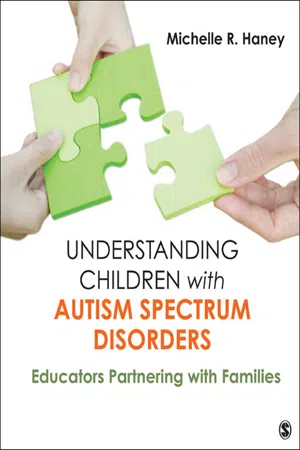
eBook - ePub
Understanding Children with Autism Spectrum Disorders
Educators Partnering with Families
- 424 pages
- English
- ePUB (mobile friendly)
- Available on iOS & Android
eBook - ePub
Understanding Children with Autism Spectrum Disorders
Educators Partnering with Families
About this book
As prevalence rates and awareness of Autism Spectrum Disorder (ASD) increase, there is a need for all educators to have a basic understanding of the disorder and how to teach affected children. Understanding Children with Autism Spectrum Disorders: Educators Partnering with Families introduces, in an accessible manner, the significant body of research and theory in the field of autism within the larger context of understanding the unique socio-cultural dimensions of individuals with ASD and their families.
Engaging and user-friendly, Michelle Haney?s text provides future educators insight into the complexity and diversity of children with ASD, the wide range of interventions and processes for making decisions about choosing interventions (teaming with parents to provide optimal educational opportunities), and the personal/professional growth that is likely to take place during such a journey.
Engaging and user-friendly, Michelle Haney?s text provides future educators insight into the complexity and diversity of children with ASD, the wide range of interventions and processes for making decisions about choosing interventions (teaming with parents to provide optimal educational opportunities), and the personal/professional growth that is likely to take place during such a journey.
Frequently asked questions
Yes, you can cancel anytime from the Subscription tab in your account settings on the Perlego website. Your subscription will stay active until the end of your current billing period. Learn how to cancel your subscription.
At the moment all of our mobile-responsive ePub books are available to download via the app. Most of our PDFs are also available to download and we're working on making the final remaining ones downloadable now. Learn more here.
Perlego offers two plans: Essential and Complete
- Essential is ideal for learners and professionals who enjoy exploring a wide range of subjects. Access the Essential Library with 800,000+ trusted titles and best-sellers across business, personal growth, and the humanities. Includes unlimited reading time and Standard Read Aloud voice.
- Complete: Perfect for advanced learners and researchers needing full, unrestricted access. Unlock 1.4M+ books across hundreds of subjects, including academic and specialized titles. The Complete Plan also includes advanced features like Premium Read Aloud and Research Assistant.
We are an online textbook subscription service, where you can get access to an entire online library for less than the price of a single book per month. With over 1 million books across 1000+ topics, we’ve got you covered! Learn more here.
Look out for the read-aloud symbol on your next book to see if you can listen to it. The read-aloud tool reads text aloud for you, highlighting the text as it is being read. You can pause it, speed it up and slow it down. Learn more here.
Yes! You can use the Perlego app on both iOS or Android devices to read anytime, anywhere — even offline. Perfect for commutes or when you’re on the go.
Please note we cannot support devices running on iOS 13 and Android 7 or earlier. Learn more about using the app.
Please note we cannot support devices running on iOS 13 and Android 7 or earlier. Learn more about using the app.
Yes, you can access Understanding Children with Autism Spectrum Disorders by Michelle R. Haney in PDF and/or ePUB format, as well as other popular books in Education & Inclusive Education. We have over one million books available in our catalogue for you to explore.
Information
SECTION III
ADDRESSING THE NEEDS OF INDIVIDUALS WITH ASD WITHIN THE SCHOOL SETTING AND THE GREATER COMMUNITY
Chapters 7, 8, 9, 10, and 11 consider research, theory, and application of the development of behavior, language, independent living, and social skills necessary for success at home, school, and within the community. Chapter 7 reviews principles of applied behavior analysis (ABA) in addressing core deficits of ASD and replacing challenging behaviors with adaptive skills. Chapter 8 considers environmental supports needed to address sensory issues and enhance learning in the classroom. Chapters 9 and 10 focus on core deficits of ASD, social communication. Chapter 9 reviews the development of language in children with typical development and ASD and considers interventions to build communication skills. Likewise, Chapter 10 presents an overview of social development and the range of atypical development often found in children with ASD. Both Chapters 9 and 10 review interventions frequently implemented in public schools to address core deficits of ASD and consider issues associated with evaluating evidence-based practices. Interventions based on principles of ABA are highlighted for addressing both communication skill development in Chapter 9 and social skill development in Chapter 10. Finally, Chapter 11 addresses issues germane to transitioning to adulthood, such as self-determination, place of residence, and employment or postsecondary education.
CHAPTER 7
INTERVENTIONS BASED ON APPLIED BEHAVIOR ANALYSIS AT SCHOOL, HOME, AND WITHIN THE COMMUNITY
In this chapter, you will learn about:
- Theoretical frameworks, operant and classical conditioning, underlying applied behavior analysis (ABA).
- Strengths of interventions and the myths surrounding ABA.
- Coordinating data analysis between home and school.
- Interventions incorporating ABA: discrete trial instruction, incidental teaching, and pivotal response training.
- Targeting challenging behaviors using ABA.
OVERVIEW OF APPLIED BEHAVIOR ANALYSIS
Theoretical Framework
Core deficits in communication, social skills, and behavior, in addition to other difficulties associated with Autism Spectrum Disorder (ASD; described in Chapter 2), often provide obstacles for the child to reach her learning potential. ABA is an intervention that teaches specific skills in a carefully determined sequence of behaviors, generally using reinforcement to increase appropriate behaviors. ABA is used in schools, clinics, homes, residential facilities, and other settings to teach children a variety of preacademic, academic, and other types of skills.
Classical Conditioning
ABA was developed from a branch of the science of behavior known as behaviorism. In 1913, John B. Watson (1878–1958), coined the term “behaviorism” (Schneider & Morris, 1987). Classical conditioning involves reflexes and a stimulus–stimulus pairing process wherein new stimuli can begin to elicit reflexive responses. In one of the most well-known examples of classical conditioning, Ivan Pavlov (1849–1936) conditioned dogs to salivate in the presence of a specific sound wherein the sound was the previously neutral stimulus. Although the origins of classical conditioning are linked to Pavlov and his classical conditioning of nonhuman animal reflexes, Watson used classical conditioning as a way of explaining human behavior.

Skinner was a neobehaviorist who developed the learning theory of operant conditioning that is the basis of many variants of applied behavior analysis today.
Operant Conditioning
Soon after Watson, B. F. Skinner (1904–1990) also began to explain human behavior, but from a different behavioral perspective. Eventually Skinner discovered the basic principles of operant behavior that today are used in the applied behavior analytic treatment of ASD. Skinner extended the analysis of behavior to include environmental consequences, and called behavior shaped by its consequences operant behavior.
CHAPTER REFLECTION: What Is Operant Behavior?
Almost everything we do is operant behavior. Examples include raising your hand in class if you have a question or avoiding someone at the supermarket when you are in a hurry. We do these things because of the effects or consequences of the behavior. Raising your hand in class gets the attention of the teacher; avoiding someone prevents us from spending time talking with them.
Practice Activity: Break down the steps involved in taking notes during a classroom discussion. Determine the behaviors associated with this task that are operant behaviors (result in a change in our environment and a consequence).
The initial applications of operant conditioning to individuals with ASD occurred in the1960s (e.g., DeMyer & Ferster, 1962; Lovaas, Berberich, Perloff, & Schaffer, 1966; Wolf, Risley, & Mees, 1964). Results indicated that different types of immediate consequences could help children with an ASD demonstrate new, more complex, socially appropriate behavior, and could help reduce inappropriate behavior.
Lovaas and the Application of ABA to Children With ASD
Using the principle of chaining simple skills together, Dr.Ivar O. Lovaas created interventions that addressed more complex skills like receptive language. Based on his clinical work and research, Lovaas created training manuals for teachers and caregivers with explicit instruction such as Teaching Developmentally Disabled Children: The ME Book (1981) and Teaching Individuals With Developmental Delays: Basic Intervention Techniques (2003). Prior to the application of ABA to children with ASD, children with ASD were often institutionalized in a hospital-like setting secluded from their family and typically developing peers.
The success of ABA along with other societal changes, such as the deinstitutionalization movement of the 1970s and federal legislation, including the Education for All Handicapped Children Act of 1975, which mandated that all children receive a free and appropriate public education in public schools, created a climate of investing in all children for optimal growth and quality of life.

ABA interventions should involve parents and teachers and take place within the child’s natural environments in an intensive manner over time.
Lovaas’ (1981) clinical work using ABA to teach children with ASD led to several key considerations that are fundamental to successful ABA programs today:
- Educational interventions must take place within the child’s natural environment. Children with ASD will not automatically generalize skills learned in hospital or clinical settings to school settings.
- Parents and teachers should be critical members of planning and administering the educational intervention of children with autism. Although working with a behavioral specialist is helpful, ultimately parents and teachers must be involved in planning, administering, and evaluating the effectiveness of interventions.
- The intervention must be intensive and take place over time. The most effective ABA interventions are those that involve frequent teaching and take place over a significant period of time.
STRENGTHS OF INTERVENTIONS BASED ON ABA
Empirical Validation
Navigating through the array of treatment options can be overwhelming and confusing to both parents and educators. The Internet can be a helpful tool, but it is filled with testimonials of popular new interventions that lack scientific support. Parents of children with ASD, desperate to help their child, are particularly susceptible to interventions that have not been subjected to rigorous scientific investigation yet are presented as a cure (Jacobson, Foxx, & Mulick, 2005).

ABA therapy is tailored to address individual needs and can address a variety of skills. Here a 3-year-old child is learning to say “fork” when presented with the object.
Validation through empirical support is a defining dimension of ABA (Baer, Wolf, & Risley, 1968; National Research Council, 2001). Objective data-based decisions drive applied behavior analytic interventions so that effectiveness can be assessed. In fact, the evaluation of the effectiveness of an individualized intervention is a defining feature of ABA. Thus, ABA meets the criteria of an empirically validated intervention stipulated in the federal legislation of both the No Child Left Behind Act and the Individuals with Disabilities Education Act.
Interventions Tailored to Address Individual Needs
Children with ASD have a wide range of intellectual abilities, cognitive strengths and weaknesses, behavioral concerns. Since ASD is a heterogeneous disorder, what may be effective for one person’s symptoms may not be effective in treating another person’s symptoms. Therefore, interventions must be tailored for each individual and evaluated objectively to determine the level of effectiveness for a particular individual.
ABA focuses on objectively and reliably assessing and evaluating the various way individuals interact with their environment (see Baer et al., 1968). ABA is meant to be practical and applied. As you will see below, the ABA methods of assessment can optimize the likelihood that a particular intervention will be effective. Interventions can be implemented with one child with an ASD or with multiple individuals in the child’s environment such as with siblings (e.g., Strain & Danko, 1995) and/or parents (e.g., Koegel, Symon, & Koegel, 2002).
Flexibility and Generalizations of Interventions
ABA interventions can address basic skills, such as pointing to a picture to indicate choice of a classroom activity. In addition, an intervention can also target more complex skills, such as how to interact with peers during recess. More complex skills are broken down into very small steps so that the child experiences success, yet masters challenging skills.
Furthermore, flexible research designs assist with practical evaluation. For example, a teacher might use different procedure on alternate days to determine the most effective procedure for that child. ABA involves multiple levels of flexibility in each assessment, intervention, and evaluation.
In addition, flexibility can lead to increased generalization of skills. Overall, flexibility allows families to access a variety of different ABA treatment options to help implement the most ecologically valid approach to treatment. In other words, an ABA intervention effective at school might need to be modified to help the child generalize the skill to the home environment. Thus, a child who is able to respond to her name in the classroom can learn to respond to her name in her home, on the playground, and at a friend’s house. Dempsey and Foreman (2001) summarized it best by stating that “properly designed and implemented ABA programs contain most if not all of the components of treatment approaches found to be most successful in supporting individuals with autism” (p. 110).
CRITICISMS AND MYTHS SURROUNDING ABA
ABA isn’t without criticisms, including the incredible investment of resources required for training, implementation, and data collection, and the early use of aversive punishment (such as mild electric shock) in working with children. It should be noted that the use of aversive punishments to treat autism was later abandoned in virtually all clinical settings. Furthermore, there was the ultimate attack on behaviorism itself, “What about the mind?” Behaviorism focuses on observable behavior and interventions such as ABA are criticized for failing to address more complex issues about thou...
Table of contents
- Cover Page
- Title Page
- Copyright
- Brief Contents
- Table of Contents
- Preface
- Acknowledgments
- Section I. The Evolving Understanding of Autism Spectrum Disorder
- Section II. Collaborating with Families for Diagnosis and Setting Educational Goals
- Section III. Addressing the Needs of Individuals with ASD within the School Setting and the Greater Community
- Appendix: Addressing CEC'S Standards for Teachers of Individuals with Developmental Disabilities/Autism
- Glossary
- Index
- About the Authors